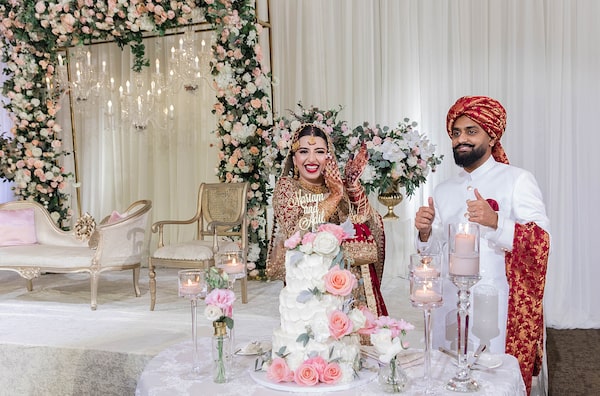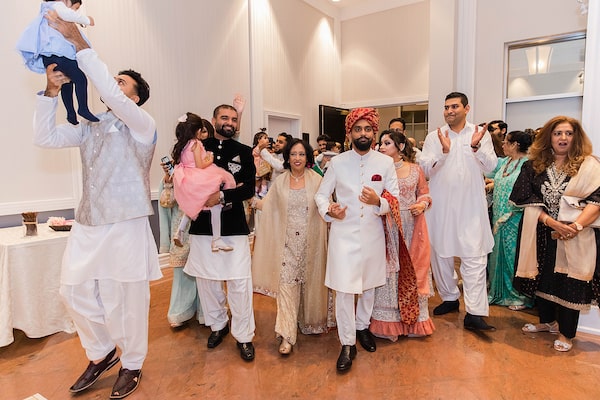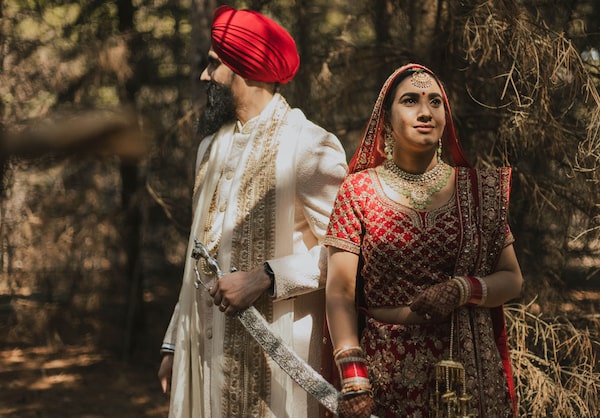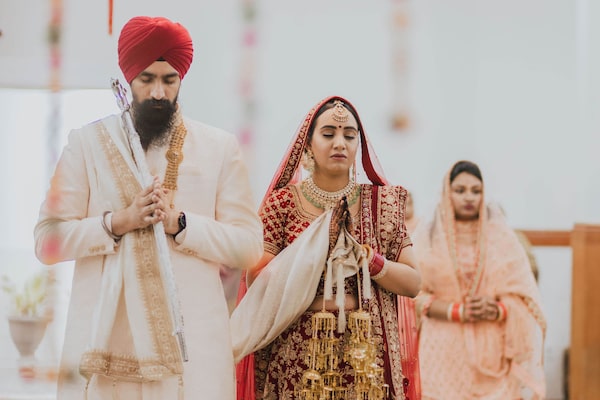
Mariam and Adil Ismail’s wedding at the Embassy Grand Convention Centre in Brampton, Ont.Photography by Azra
Like so many other brides whose weddings were turned upside-down by COVID-19, Mariam Ismail’s big day didn’t look the way she’d originally envisioned. Instead of hosting it at the Fairmont Royal York in Toronto, she held it at Embassy Grand Convention Centre in Brampton, Ont.’s north end. And instead of inviting 700 guests, she only had 200, in keeping with Ontario pandemic restrictions. But while the venue and guest list were scaled back, spending wasn’t.
On the menu for her guests was typical Pakistani cuisine – an impressive spread of appetizers, curries, rice and desserts. The room was intricately decorated with a mix of fresh and silk flowers worth $20,000, and the event was followed by another reception from the groom’s side a day later.
While many couples across Canada postponed their weddings indefinitely or opted for simple elopements or family-only ceremonies at home during the pandemic, this was not the trend in Brampton, home to one of the largest South Asian diasporas in Canada. Brides and grooms had to make major pandemic pivots – such as reducing the number of guests from thousands to sometimes less than a dozen – but many have not compromised at all when it comes to the splendour of events.
“I think the people are just making it a little bit more intimate. So, the size gets reduced, but other than that, people aren’t really scaling down,” says Roxy Zapala, an event planner with Art of Celebrations in Mississauga. In many cases, she adds, “it’s other way around. They’re going bigger on other things like more decor, expensive dresses and more food.”

While many couples across Canada postponed their weddings or opted for simple elopements or family-only ceremonies at home, this was not the trend in Brampton, home to one of the largest South Asian diasporas in Canada.Azra/Photography by Azra
Wedding vendors who cater to these couples have likewise been forced to make major pivots. Some changed their business models, while others launched new ventures to help sustain the grandiose nature of South Asian weddings, which in some cultures can involve several events such as choreographed dances and musical events spread over a week.
Prepandemic, Amna Rather’s South Asian clientele gravitated toward luxurious, grand-scale events accommodating 600 to 700 people. Then in 2020, Lemon Truffle, her event decoration company, had no business at all. In 2021, things improved, but couples were scaling down party sizes to just 15 or 20 guests.
“So the wedding that I had originally planned with grand receptions and many other events, like planning a big project, literally came down to home decor only,” Rather said. To entice clients she’s dropped her minimum spend requirements.
One new expense for many South Asian couples is live-streaming technology, with an average cost of $1,000 to $3,000 depending on the number of days of festivities and the size of the ceremony. In some cases, it’s a bigger priority than traditional photography or videography.
“I’m starting to book a year in advance,” says Jaspaul Singh, who owns a video production company that specializes in live-streaming events. “When I started it, I was booking a week or a month in advance.”
Singh ditched his corporate job during the pandemic, turning a decade-long hobby into a full-time endeavour. He invested more than $15,000 on equipment and cameras and created a couple of teams to cover many events simultaneously.

Navneet Kaur and Simar Gill redirected money saved from their scaled back wedding, due to the pandemic, to clothing and photoshoots.Twosweetapples
The growing trend has helped relatives overseas watch weddings in cases where the pandemic presented insurmountable obstacles.
Originally from Chandigarh in India, Navneet Kaur, a Ph.D. student at Ontario’s Lakehead University, met Simar Gill (who now goes by Kaur) in 2019. The couple got engaged in September, 2020, with plans to marry in April, 2021. Travel restrictions from India forced them to make the difficult decision to have the wedding without Kaur’s parents present.
“My father was supposed to hand me over in the groom’s hand, but my brother did it for him. Later mom told me that he was constantly crying while watching it live,” says Kaur, whose parents provided their blessings – a crucial part of the Sikh ceremony – virtually.
About 200 guests from around the world tuned into the event through the livestream – a service that unexpectedly provided another benefit. While videographers can sometimes take upward of six months to deliver an edited copy of the wedding video, Kaur and Gill were able to watch their ceremony just a few hours later.
Ismail’s wedding planning was also marked by uncertainty through many phases of lockdown – right up until the weekend of her wedding last May. Her parents were stuck in Pakistan because of a travel ban and later her husband’s father died suddenly after testing positive for COVID-19 four months before the big day.

Navneet Kaur and Simar Gill on their wedding day.Twosweetapples
The couple decided to postpone. “It turned out to be one of the saddest, the darkest weekends,” she said. “I met all my relatives at my father-in-law’s funeral, on the day my wedding was anticipated.”
The couple re-evaluated their priorities and changed the extravagant wedding plan to a small-sized nikah ceremony held with immediate family members at a mosque. They decided to have a rukhsati reception, when the groom takes the bride to their home, at the Embassy Grand in October, after they’d marked four months of mourning for Ms. Ismail’s father-in-law.
Changing things so suddenly came with great expense from last-minute planning, rescheduling fees, inflated prices and safety protocols. Cancelling and rebooking the photographer alone came with a $500 surcharge.
But now, with everything in the rear-view mirror, Ismail can look back with fond memories. ”We had a really good team to help us through navigating all the challenges of COVID,” she said. “I mean our vendors, family and friends, who were able to hold out the fort and make this very, very special for us.”
Things also worked out for Kaur. The couple scaled back on the number of ceremonies, choosing only one haldi ceremony (a pre-wedding holy bath when a mixture of turmeric, oil and water is applied to both bride and groom) and Anand Karaj, the ceremony of joy, at the local gurdwara.
She was pleasantly surprised by how much she enjoyed the scaled-down affair. “We were able to mingle with each guest more and make it more memorable without the stress of planning a large wedding.”
Our Morning Update and Evening Update newsletters are written by Globe editors, giving you a concise summary of the day’s most important headlines. Sign up today.